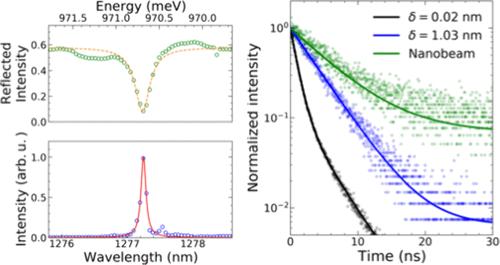硅G中心亮purcell增强单光子发射
IF 9.1
1区 材料科学
Q1 CHEMISTRY, MULTIDISCIPLINARY
引用次数: 0
摘要
硅G中心在可扩展的硅平台上作为单光子源显示出重要的前景。但这些色心具有较大的非辐射衰减和较低的德拜-沃勒因子,限制了它们在量子应用中的可用性。在这项工作中,我们通过将硅G中心与纳米光子腔耦合,展示了明亮的purcell增强发射。纳米束腔将单个G中心的自发发射率提高了6倍,当考虑到声子边带的衰减时,对应的Purcell因子大于31。我们获得了0.97 ns的自发发射速率,这是硅中报道的最快的单光子发射速率。与先前报道的值相比,通过这种辐射增强,我们实现了发射器亮度的一个数量级提高。这些结果为在硅光子芯片上开发可扩展量子光源铺平了道路。本文章由计算机程序翻译,如有差异,请以英文原文为准。

Bright Purcell-Enhanced Single Photon Emission from a Silicon G Center
Silicon G centers show significant promise as single photon sources in a scalable silicon platform. But these color centers have large nonradiative decay and a low Debye–Waller factor, limiting their usability in quantum applications. In this work, we demonstrate bright Purcell-enhanced emission from a silicon G center by coupling it to a nanophotonic cavity. The nanobeam cavity enhances the spontaneous emission rate of a single G center by a factor of 6, corresponding to a Purcell factor greater than 31 when accounting for decay into the phonon sideband. We obtain a spontaneous emission rate of 0.97 ns, which is the fastest single photon emission rate reported in silicon. With this radiative enhancement, we achieve an order of magnitude improvement in emitter brightness compared to previously reported values. These results pave the way for scalable quantum light sources on a silicon photonic chip.
求助全文
通过发布文献求助,成功后即可免费获取论文全文。
去求助
来源期刊

Nano Letters
工程技术-材料科学:综合
CiteScore
16.80
自引率
2.80%
发文量
1182
审稿时长
1.4 months
期刊介绍:
Nano Letters serves as a dynamic platform for promptly disseminating original results in fundamental, applied, and emerging research across all facets of nanoscience and nanotechnology. A pivotal criterion for inclusion within Nano Letters is the convergence of at least two different areas or disciplines, ensuring a rich interdisciplinary scope. The journal is dedicated to fostering exploration in diverse areas, including:
- Experimental and theoretical findings on physical, chemical, and biological phenomena at the nanoscale
- Synthesis, characterization, and processing of organic, inorganic, polymer, and hybrid nanomaterials through physical, chemical, and biological methodologies
- Modeling and simulation of synthetic, assembly, and interaction processes
- Realization of integrated nanostructures and nano-engineered devices exhibiting advanced performance
- Applications of nanoscale materials in living and environmental systems
Nano Letters is committed to advancing and showcasing groundbreaking research that intersects various domains, fostering innovation and collaboration in the ever-evolving field of nanoscience and nanotechnology.
 求助内容:
求助内容: 应助结果提醒方式:
应助结果提醒方式:


